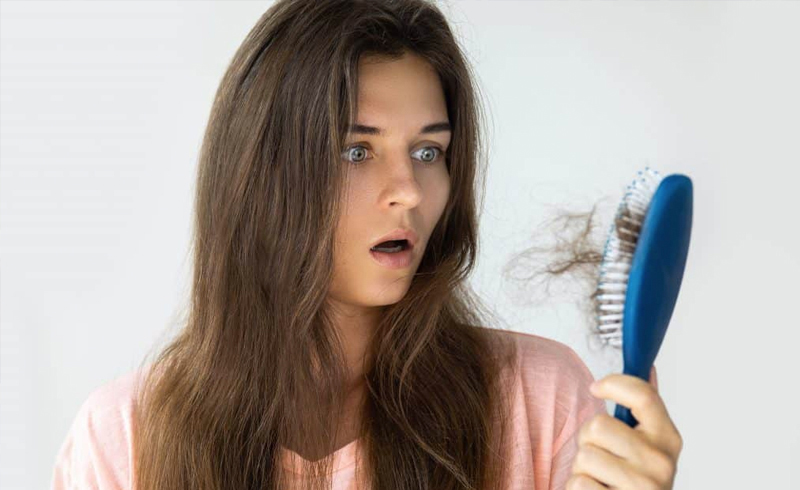Here's exactly how to fix your damaged hair whether you had a bad dye job or just seem to lose chunks of hair for no reason.

Each product we feature has been independently selected and reviewed by our editorial team. If you make a purchase using the links included, we may earn commission.
Here's exactly how to fix your damaged hair whether you had a bad dye job or just seem to lose chunks of hair for no reason.
Your strands go through a lot. There’s drying, styling, coloring, and plus the ripple effect of daily tension. So how do you fix damaged hair without giving up your highlights and daily hit of the curling iron? Here, experts talk you through the damage done and how you can get back that healthy shine.
Here's exactly how to fix your damaged hair whether you had a bad dye job or just seem to lose chunks of hair for no reason.
Your strands go through a lot. There’s drying, styling, coloring, and plus the ripple effect of daily tension. So how do you fix damaged hair without giving up your highlights and daily hit of the curling iron? Here, experts talk you through the damage done and how you can get back that healthy shine.
Chemical Harm
When you alter your hair color with dye or bleach or the texture with a perm solution or a relaxer, there is a chemical change within the strands’ inner core, called the cortex. Do this too often or intensely, and you can cause major damage. The extreme option for how to fix damaged hair: Cut as much off as you can, and start fresh. Or less drastic: “Get protein treatments at a salon or use protein-based products at home,” says trichologist and colorist David Adams. “But it’s a process. Expect a year to get strong, soft, and shiny hair again.” Try Redken Extreme Anti-snap Leave-In Treatment (ulta.com).Congested Scalp
The biggest culprits: “Dry shampoo and root touch-up sprays,” says Adams. “These sit on the scalp and can clog your hair follicles.” A follicle typically has two or three hairs growing out of it. But when product builds up, follicles shrink, so you get only one or two. As for how to fix damaged hair like this, Adams recommends exfoliating with a scrub like Thicker Fuller Hair Purifying Sugar Scalp Scrub (walgreens.com) and using products with zinc, a building block of hair. You can also clear clogged follicles and promote growth with a professional treatment like the HydraFacial Keravive, which extracts impurities and infuses the scalp with growth factors and protein. (For more budget buys and luxurious picks, check out these scalp scrubs for buildup and beyond)Dullness
Think of your hair’s outer layer (the cuticle) like a fish’s scales. When they lie flat, they reflect light and look shiny. “If some of the cuticle’s scales are missing or not lying down because of aggressors like drying, light can’t bounce off evenly, and hair looks dull,” says Adams. Smooth the cuticle with a leave-in like Aveda Nutriplenish Leave-In Conditioner (nordstrom.com). (Steal these pro tips to get that iconic "glass hair.")Frizz
“When your hair is damaged, the cuticle opens up and strands tend to get caught on one another, causing frizz and tangles,” says Peter Corvington, a hairstylist at Spoke & Weal in New York. How to fix damaged hair like this? Opt for a styling product that will seal the cuticle and protect it from further assaults, like Beachwaver Great Barrier Heat Protectant Hairspray (ulta.com). Also, avoid touching your hair, which can rough up the cuticle again, says Adams. (Related: Hair Masks That Combat Dryness and Frizz)Heat Damage
It’s tempting to turn up your curling iron to 450 degrees to get perfect waves fast. But unless you have very coarse, thick locks, that temperature can burn your hair’s cuticle and cause breakage. So dial down to 200 degrees and work your way up if needed. Also, look for a protein-based shampoo. “Hair is made up of protein, so that’s what it needs for repair,” says Adams. A revitalizing shampoo like Virtue Labs Recovery Shampoo (sephora.com) is a go-to solution when it comes to how to fix damaged hair. (As is this three-step leave-in treatment.)Hair Loss
“When you’re stressed, you might stop eating properly and skip exercise, and both of these deficiencies can lead to hair thinning,” says Adams. Because of the hair’s growth cycle, the loss may occur three months after a stressful event. If you’re wrapping a hair tie around your ponytail an extra time, “your first step is to reduce stress as much as possible and prioritize rest and good nutrition,” says dermatologist Arash Akhavan, M.D. “It could take three months before you see any result.” Just keep at it. (Here's exactly how to tell if all that shedding is normal.)Friction
Wet hair holds water and stretches. “Healthy hair can stretch three times its original length and then spring back,” says Adams. “But an unhealthy strand breaks off when you stretch it with a towel, a brush, or an elastic band.” The solution for how to fix damaged hair like this: “Treat your hair like a fine fabric,” says colorist Colleen Flaherty. After washing, wrap hair in an Aquis Rapid Dry Lisse Hair Turban (sephora.com), a soft microfiber towel that wicks away water quickly. And swap tight elastics for a silk scrunchie like those from Slip (sephora.com).
See more at: Shape
![[feature] 6 Most Common Hair Problems and How to Fix Them](https://blogger.googleusercontent.com/img/b/R29vZ2xl/AVvXsEgT3gKuI1SoZSSQkIYAZIZXiiF2UqESC3Tau2s9M9sFmF0DMptWXnDo2lsTQtQ0c5BUl9rmtM4kZlixSofHxF1Lor2OyZ9x1UbWvs6UF8FMKZN6ThlbRmn7em5tVnlXlmyXSSn5hLZ0J9rm/s1600/women+1.jpg)
























